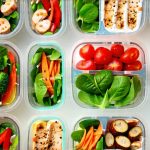Bloating and stomach discomfort are incredibly common experiences, impacting millions daily. It’s often dismissed as just “part of life,” but for many, it significantly diminishes quality of life – causing pain, anxiety, and even social withdrawal. The causes are complex, ranging from dietary choices to stress levels to underlying digestive sensitivities. While a healthcare professional should always be consulted to rule out serious conditions or identify specific triggers, proactive food preparation can play a massive role in mitigating these symptoms and regaining control over your gut health. This isn’t about restrictive dieting; it’s about intelligent choices and mindful techniques that empower you to feel better, more consistently.
The good news is that even small adjustments to how you handle food – from grocery shopping to cooking methods – can yield substantial benefits. Often, bloating isn’t necessarily triggered by what you eat, but how it’s prepared or combined. Understanding the potential culprits and adopting strategic prep habits allows for a more comfortable digestive experience. This article will explore practical strategies for minimizing discomfort through mindful food preparation, focusing on techniques that are achievable for everyday life and geared towards long-term well-being rather than quick fixes. It’s about building sustainable habits that support your body’s natural processes. If you’re experiencing frequent discomfort, recognizing the warning signs of more serious conditions is always a good first step.
Understanding Food & Bloating Triggers
Bloating isn’t usually a sign of something seriously wrong, but it signals that your digestive system is working hard or reacting to something. Certain foods are more likely to contribute to gas and discomfort than others. These aren’t necessarily “bad” foods; rather, they might require mindful preparation or portion control for individuals sensitive to them. – Legumes (beans, lentils) often contain raffinose, a complex sugar that the body struggles to digest easily. – Cruciferous vegetables (broccoli, cauliflower, cabbage) are incredibly nutritious but also produce sulfur-containing gases during digestion. – Dairy products can be problematic for those with lactose intolerance or sensitivity. – Artificial sweeteners and high-fructose corn syrup often cause digestive upset in sensitive individuals. – Carbonated beverages introduce excess gas into the digestive system.
Beyond specific foods, how we eat matters just as much. Eating too quickly, swallowing air while eating, and large portion sizes can all contribute to bloating. Food intolerances, even mild ones, can accumulate over time leading to noticeable discomfort. Many people find that combining certain foods (like fruit with protein) leads to faster fermentation in the gut, resulting in gas production. Identifying your personal triggers is key – keeping a food diary for a week or two can reveal patterns and help you pinpoint problematic items. It’s not about eliminating entire food groups but learning how to manage them effectively through preparation and mindful consumption.
It’s also crucial to remember that the gut microbiome plays an enormous role in digestion. A healthy, diverse gut flora helps break down foods efficiently and reduces gas production. Focusing on prebiotic foods (those that feed beneficial bacteria) like garlic, onions, asparagus, and bananas can support a healthier gut environment over time. Probiotic-rich fermented foods – yogurt, kefir, sauerkraut – can also contribute to improved digestion, but should be introduced gradually as some individuals may experience initial discomfort. Managing indigestion after meals is also a good habit to develop.
Soaking & Sprouting for Improved Digestibility
Many common bloating triggers are significantly easier to digest when properly prepared. Soaking legumes before cooking is a classic example. This process reduces raffinose levels and makes them less likely to cause gas. – Rinse 1 cup of dried beans thoroughly. – Place in a large bowl and cover with at least three times the amount of water. – Add 1 tablespoon of apple cider vinegar (this helps break down phytates). – Soak for at least 8 hours, or preferably overnight. – Drain the soaking water and rinse before cooking.
Similarly, sprouting grains and seeds – allowing them to germinate briefly – activates enzymes that aid in digestion and increases their nutritional value. This is a relatively simple process that can be done with things like quinoa, lentils, and chia seeds. It’s not just about making food more digestible; it’s also about unlocking nutrients that are otherwise unavailable. Sprouting reduces phytic acid, an anti-nutrient that hinders mineral absorption. Food consistency tips can be particularly helpful when introducing new foods or preparation methods.
Beyond legumes and grains, even some vegetables benefit from pre-preparation. Chopping cruciferous vegetables and letting them sit for 10-20 minutes before cooking allows enzymes called myrosinase to break down compounds responsible for gas production. This doesn’t eliminate the gases entirely but can reduce their impact significantly. These simple techniques require a little extra time upfront, but they often pay dividends in terms of digestive comfort.
Mindful Cooking Methods
The way you cook your food can also influence its digestibility. Overcooking vegetables can destroy beneficial enzymes and make them harder to break down. Steaming or lightly sautéing vegetables preserves more nutrients and makes them easier on the stomach. Deep-fried foods are notoriously difficult to digest, as they’re high in fat and require significant digestive effort. Opt for baking, grilling, or air frying whenever possible.
Consider incorporating spices known to aid digestion. Ginger, cumin, fennel seeds, and turmeric have all been used traditionally to relieve bloating and improve gut health. Adding a pinch of grated ginger to your meals or sipping on fennel seed tea after eating can be surprisingly effective. Avoid excessive oil in cooking; healthy fats are important but large amounts can slow down digestion and contribute to discomfort.
Slow cooking is another beneficial technique, particularly for tough cuts of meat or fibrous vegetables. Long, slow cooking breaks down proteins and fibers, making them easier to digest. Soups and stews, often cooked slowly, are generally well-tolerated by those with sensitive stomachs because the ingredients have been pre-digested during the prolonged cooking process. If you’ve had a particularly difficult time, returning to normal eating gradually can be very beneficial.
Portion Control & Meal Timing
Even the most perfectly prepared food can cause bloating if consumed in excessive quantities. Portion control is vital for minimizing digestive stress. Smaller, more frequent meals are often easier to digest than large, infrequent ones. This allows your body to focus on breaking down food without being overwhelmed. – Start with smaller portions and assess how you feel before going back for seconds. – Use a smaller plate; it’s a psychological trick that helps reduce portion sizes. – Pay attention to satiety signals – stop eating when you’re comfortably full, not stuffed.
Meal timing also plays a role. Eating large meals right before bed can disrupt sleep and hinder digestion. Allow at least 2-3 hours between your last meal and bedtime. Avoid rushing through meals; take your time, chew thoroughly, and savor each bite. Chewing food properly breaks it down mechanically, making it easier for the digestive system to process. Managing upset stomach during busy times can be particularly challenging but important.
Finally, hydration is crucial. Drinking plenty of water throughout the day helps keep things moving smoothly in the digestive tract. Dehydration can lead to constipation, which exacerbates bloating and discomfort. Avoid drinking large amounts of liquid during meals, as this can dilute digestive enzymes. Instead, sip water between meals or after eating. Remember, these are all pieces of a larger puzzle; finding what works best for you requires experimentation and self-awareness.


















